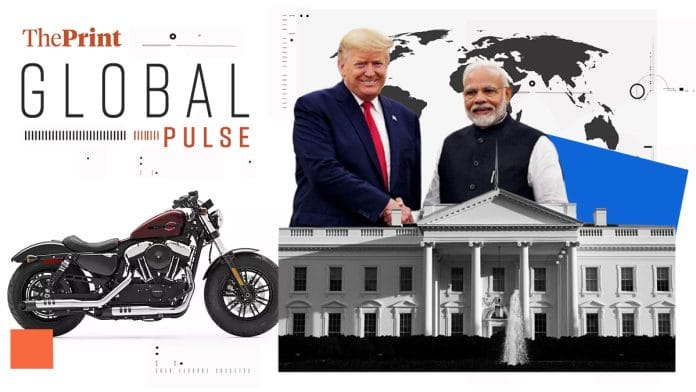New Delhi: The Economist has called the race: India isn’t winning the contest against China.
For proof, in ‘Why India isn’t winning the contest with China’, The Economist looks at the South Asian neighbourhood: Prime Minister Narendra Modi’s “regional scorecard looks patchy at best”, it says.
In the last eighteen months, India-friendly leaders have been ousted in Bangladesh, Sri Lanka, Maldives, and Nepal. What complicates things is that several Adani projects in these countries are also mired in controversy, following American accusations of bribery against Gautam Adani.
“The to and fro is partly down to regional leaders playing Asia’s giants against each other. But it also stems from poor diplomacy,” writes The Economist. It looks like New Delhi is wasting its opportunities in a period of “relative Chinese weakness”, especially despite the edge its geographical and cultural links give it over Beijing.
The Economist reminds us that the West is watching. “Many Western officials fear that India’s regional diplomacy often backfires or conflicts with their own. Some say it mirrors China’s behaviour by backing despots, promoting opaque business deals and stirring chauvinistic nationalism at home. Donald Trump’s return adds new challenges. How will India adapt if he strikes a bargain with China?”
Take Bangladesh, the biggest regional “swing state”. By building alliances with a regime and not a state, India’s strategy “exposed an outdated approach to the region”.
“For decades, India has largely backed whoever is in power so long as they furthered its security interests. Mr Modi built on that but relied more on economic muscle,” the article observes.
Overall, there’s a far more fundamental problem that India needs to solve. Modi might be promoting India as an emerging world power and a champion of the Global South, and yet “officials across the region say it is still unclear what India stands for in its own backyard.”
“Until it defines that, sceptical neighbours will continue to hedge their bets. And China will reap the rewards,” The Economist concludes.
But for the time being, Donald Trump’s return to the White House is delaying these regional calculations as India is trying to avoid a trade war with the US.
The work has already begun. India slashed import duties on motorcycles last week, a preemptive move to smoothen the entry of Harley Davidson in India—US motorcycle exports to India were worth $3 million last year.
“India hopes it is ahead of the game – but will its tariff cuts satisfy Trump, or is trade action still on the table?” asks the BBC in ‘India looks on nervously as Trump wields tariff threat’.
Trump has long called India a “tariff king” and a “big abuser” of trade ties because India enjoys a trade surplus with the US, its top trading partner. In the BBC report, Soutik Biswas and Nikhil Inamdar write that experts see India as “prime target under Trump’s ‘America First’ policy, which seeks reciprocal action against high import taxes and reassesses trade with large US deficits.”
Agricultural market access, for example, seems to be a major sticking point for the US. India dropped retaliatory tariffs on US-produced goods like almonds, walnuts and apples, but Trump might demand more. But there’s plenty of political sensitivity around agriculture in India, and Modi won’t want to upset the balance.
It’s not all doom and gloom though: India’s strategic ties with the US could help ease the friction. Plus, concessions like the “willingness to accept the deportation of undocumented Indian migrants in the US without pushing back has also sent a positive signal,” the BBC reports.
The next question is whether or not Modi’s personal rapport with Trump will withstand the stress of bilateral relations. “Some clarity will come when the Indian prime minister visits the White House,” the BBC concludes on a hopeful note.
Meanwhile, The Guardian reports on a uniquely Indian solution to a geopolitical problem: praying to Hindu Gods to get visas to emigrate, so they can leave the country forever.
In ‘Indians flock to Hindu temples to pray for US visas after Trump crackdown’, Penelope MacRae reports that many Indian professionals have been flocking to Hindu temples, such as the famous Chilkur Balaji temple in Hyderabad. Hundreds are also visiting the Chamatkari Hanuman temple in Ahmedabad to pray to the almighty deity “Visa Hanuman”.
Visa applicants are reportedly placing their passports before Lord Hanuman, and then reciting a devotional hymn. Others are giving up meat, alcohol, garlic, and onions for 41 days in the hopes that they will get the visa. Devotees have apparently received approvals within hours of performing rituals, even after multiple rejections.
“Emigrating to the US has long been a status symbol for many Indians. But Trump has put such ambitions in doubt, demanding tougher visa vetting procedures,” The Guardian article says.
There’s also been a split amongst Trump’s support groups over the H-1B visa programme, of which two-thirds of the recipients are Indian. It’s caused further anxiety for skilled professionals looking to work in the US.
“At Hyderabad’s Chilkur Balaji temple – dubbed the ‘Visa God’ shrine – aspiring emigrants have been chanting prayers, performing rituals and completing 108 circumambulations barefoot, hoping for divine intervention,” The Guardian reports. At a Hanuman temple in Delhi, devotees “write their wishes on slips of paper, which are placed before the deity and chanted over before being stored in a sacred box.”
(Edited by Sanya Mathur)
Also Read: How Reliance Jio IPO could be a blockbuster listing & Elon Musk Starlink eyeing Indian market







“Visa Hanuman” Gah! that’s funny. Is there a deity that I can go to for help with being overrun by immigrants? I mean besides the god of war.
I would gladly sacrifice a goat should they go somewhere else and work in some other trade besides software engineering.
This problem wouldn’t have arised if India had followed free market capitalism and become a developed country. She was forced to follow socialism and remain a poor, third world country.